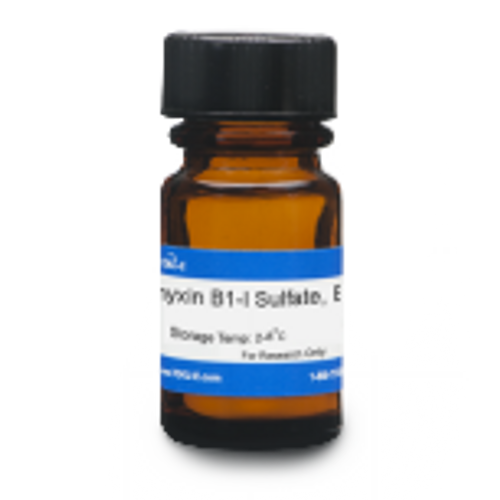Polymyxin B1-I Sulfate, EvoPure (syn: Isoleucine (Ile)-B1) is one of the individual polypeptide components in Polymyxin B Sulfate. Polymyxin B1-I contains, among other amino acids, an L-isoleucine residue in place of the L-leucine reside found in the other polymyxin fractions. The unique fatty acid group found in B1-I is 6-methyloctanoic acid (6-MOA), the same group found in Polymyxin B1. Results from in vitro studies have shown marginal differences in MIC data when comparing the fractions.
We also offer:
- Polymyxin B Sulfate, USP (P007)
- Polymyxin B1 Sulfate, EvoPure (P037)
- Polymyxin B2 Sulfate, EvoPure (P039)
- Polymyxin B3 Sulfate, EvoPure (P040)
- Polymyxin B6 Sulfate, EvoPure (P054)
- Polymyxin E1 Sulfate, EvoPure (P055)
- Polymyxin E2 Sulfate, EvoPure (P056)
EvoPure products are purified single antibiotic fractions, most are >99% pure. Highly pure EvoPure Polymyxin products can be used to analyze the specific effects of individual Polymyxin B fractions.
| Mechanism of Action | Polymyxin B targets and alters permeability lipopolysaccharide (LPS) of Gram negative bacteria leading to lysing of the cell. Polymyxin B only needs to interact with LPS, it is not required to enter the cell. |
| Spectrum | Polymyxin B sulfate targets the outer membrane of Gram-negative bacteria especially Pseudomonas aeruginosa. Polymyxin B3 was the most active polymyxin fraction according to research done by Kassamali et al, and there was a synergistic effect using Polymyxin B3 and B1-I (Kassamali et al, year) |
| Microbiology Applications | Polymyxin B Sulfate is commonly used in clinical in vitro microbiological antimicrobial susceptibility tests (panels, discs, and MIC strips) against gram negative microbial isolates. Medical microbiologists use AST results to recommend antibiotic treatment options. Representative MIC values include:
|
| Plant Biology Applications | Polymyxin B sulfate was successfully tested to counteract phytopathogenic Gram-negative bacterial growth including different strains of Pseudomonas viridiflava and Erwinia carotovora. Polymixin B sulfate was shown to reduce bacterial growth of different strains of Pseudomonas viridiflava at low concentrations, (0.08 µg/ml) and Erwinia carotovora growth at slightly higher concentrations (0.25 µg/ml) (Selim et al. 2005). |
| Molecular Formula | C56H98N16O13 • xH2O4S (lot specific) |
| References |
Kassamali, et al. used Polymyxin B1, polymyxin B2, polymyxin B3, and polymyxin B1-I (TOKU-E) to test for synergistic and antagonistic effects against various Gram-negative organisms. Cao G et al (2009) Development and validation of a reversed-phase high-performance liquid chromatography assay for Polymyxin B in human plasma. J. Antimicrob. Chemother. 62(5):1009-1014 PMID 18765414 Mueller MJ, Brodschelm W, Spannagl E and Zenk MH (1993) Signaling in the elicitation process is mediated through the octadecanoid pathway leading to jasmonic acid. Proc. Natl. Acad. Sci. USA 90(16):7490-7494 PMID 11607420 Newton BA (1956) The properties and mode of action of the Polymyxins. Bacter. Rev. 20(1):14-27 PMID 13303920 Orwa JA et al (2001) Isolation and structural characterization of Polymyxin B components. J Chromatogr A 912(2):369-373 PMID 11330807 Selim S, Negrel J, Govaerts C, Gianinazzi S and Tuinen van D (2005) Isolation and partial characterization of antagonistic peptides produced by Paenibacillus sp. strain B2 isolated from the sorghum Mycorrhizosphere. Appl. Environ. Microbiol. 71(11):6501–6507 PMID 16269674 Tam VH, Cao H, Ledesma, KR, Hu M (2011) In vitro potency of various Polymyxin B components.55(9):4490-491 PMID 21709096 Zavascki AP, Goldani LA, Li J and Nation RL (2007) Polymyxin B for the treatment of multidrug-resistant pathogens: A critical review. J. Antimicrob. Chemother. 60(6):1206-1215 PMID 17878146 |
| MIC | P. aeruginosa (ATCC 27853)| 4 |1666| A. baumannii (ATCC BAA 747)|1|1666| K. pneumoniae ATCC 13883|2|1666| P. aeruginosa (9019)|1|1666| A. baumannii (1261)|1|1666| K. pneumoniae (VM9)|1|1666| |








